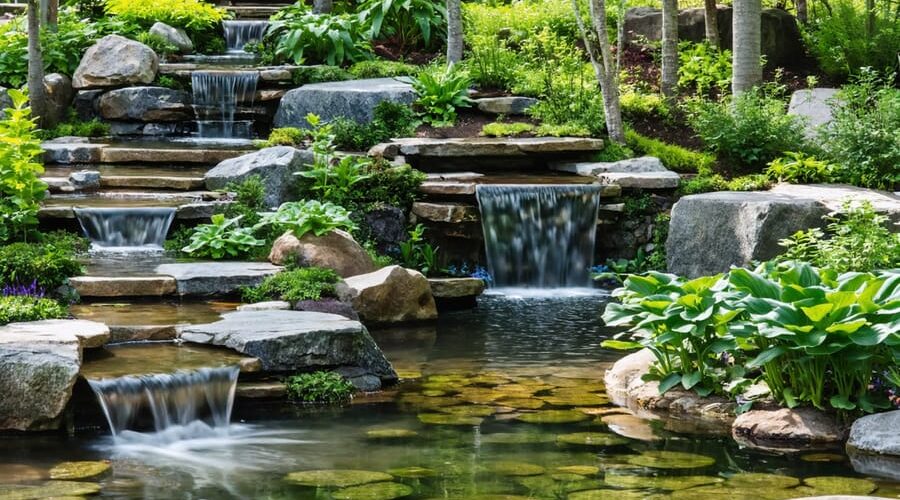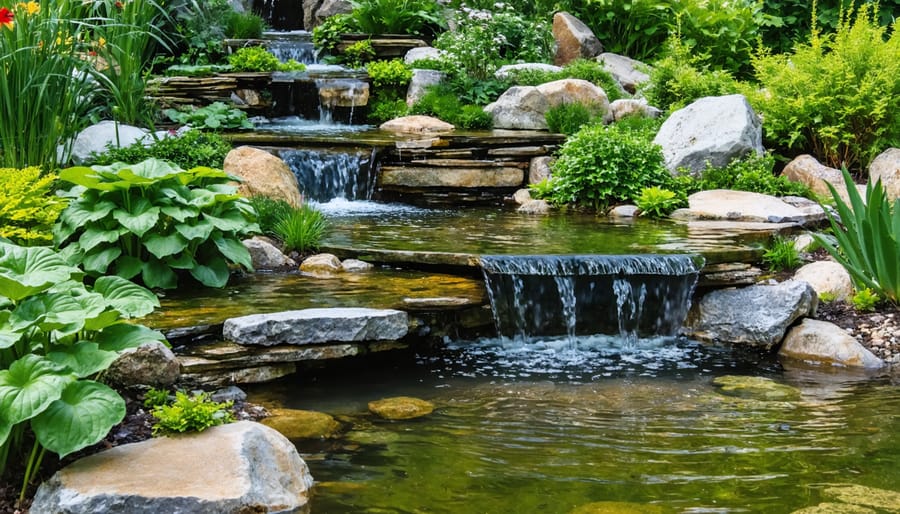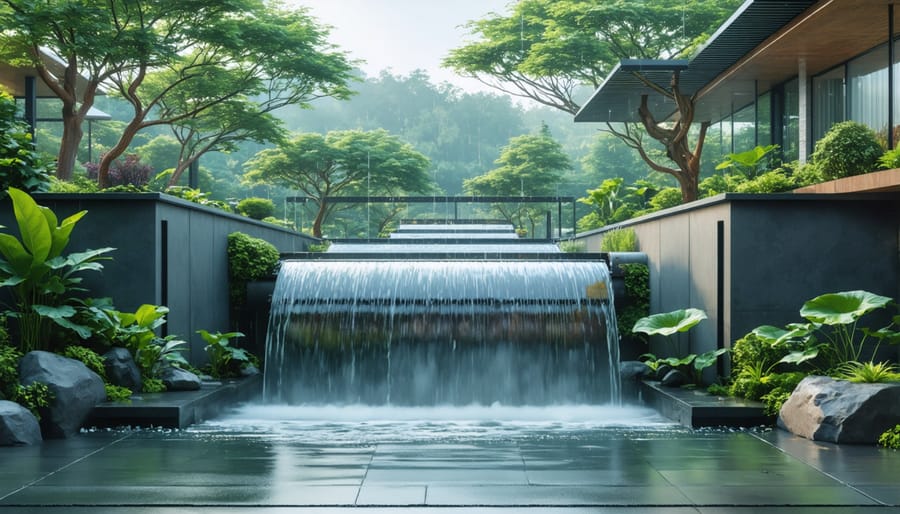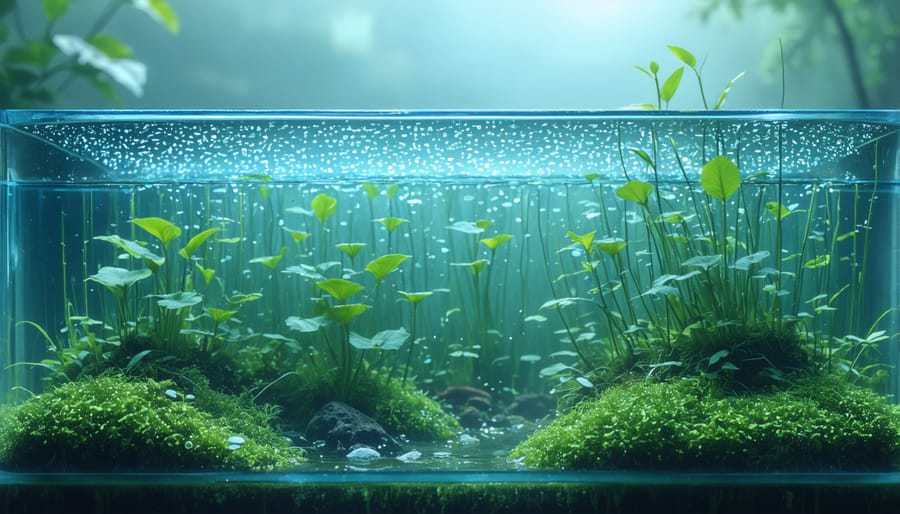
Transform Your Water Garden into a Self-Sustaining Oasis
Transform your garden into a living aquatic ecosystem through smart water management that benefits both nature and your wallet. Install rainwater harvesting systems to capture and store precipitation, reducing reliance on municipal water supplies by up to 40%. Integrate native aquatic plants strategically around pond edges to naturally filter water, minimize evaporation, and create wildlife habitats. Implement a recirculating water system with energy-efficient pumps that operate on timers, cutting electricity usage while maintaining optimal water quality. Monitor water levels weekly and adjust circulation patterns seasonally to prevent stagnation and reduce maintenance needs.
This water-wise approach not only preserves our most precious resource but also creates a self-sustaining environment that thrives with minimal intervention. By combining these practices, pond owners can reduce water consumption by up to 60% while fostering a healthier, more resilient aquatic environment. These techniques work in harmony with natural processes, making sustainable water management both effective and accessible for any garden size.

Smart Water Conservation Strategies
Rainwater Harvesting Systems
Rainwater harvesting is one of the smartest ways to maintain a sustainable water garden while reducing your environmental impact and water bills. By implementing proper rain garden techniques, you can create a self-sustaining system that works with nature rather than against it.
Start with simple collection methods like installing rain barrels or tanks beneath your downspouts. These containers can store hundreds of gallons of water for use during drier periods. For a more advanced setup, consider installing underground storage tanks connected to a pump system, which can automatically water your garden when needed.
The collected rainwater can be used in multiple ways:
– Direct irrigation for plants and water features
– Topping up ponds during dry spells
– Creating natural water flows in stream features
– Maintaining bog gardens and wetland areas
To maximize efficiency, incorporate permeable surfaces and swales into your garden design. These features help slow down water flow and allow it to naturally seep into the ground, reducing runoff and erosion. Adding a first-flush diverter to your system helps filter out initial roof debris, ensuring cleaner water for your garden.
Remember to position collection points strategically around your property to capture maximum rainfall. Consider adding overflow mechanisms to handle heavy rain events and prevent flooding. With proper planning, your rainwater harvesting system can provide most of your garden’s water needs while supporting local wildlife and reducing strain on municipal water supplies.

Efficient Circulation Design
Creating an efficient water circulation system is like designing a mini ecosystem – it’s all about working smarter, not harder. Start by positioning your pump at the deepest point of your water feature, as this naturally helps minimize energy usage while maximizing water flow. A good rule of thumb is to ensure your system circulates the entire water volume once every two hours.
Choose energy-efficient pumps that are properly sized for your water feature – bigger isn’t always better! A pump that’s too powerful wastes electricity, while one that’s too weak won’t do the job effectively. Look for variable-speed pumps that allow you to adjust flow rates based on seasonal needs.
Strategic placement of return lines and aerators can create natural circulation patterns. Position returns to create gentle movement across the surface, which helps with oxygenation and prevents stagnant areas. Using gravity to your advantage can reduce the workload on your pump – consider incorporating cascades or waterfalls that naturally help move water.
Install pre-filters before your pump to prevent debris from clogging the system. This simple step reduces maintenance needs and helps your pump run more efficiently. Consider using biological filtration methods, like plant zones or rock beds, which naturally clean water while creating beautiful focal points.
For optimal energy savings, set your circulation system on a timer, running it more during peak daylight hours and reducing flow at night when biological activity is lower.
Natural Filtration Solutions
Plant-Based Filtration
Aquatic plants are nature’s own water purifiers, creating a natural water purification system that’s both beautiful and effective. Water lilies, cattails, and rushes don’t just add visual appeal to your pond; they work tirelessly to filter out excess nutrients and maintain water clarity.
These plant-based filters work through a fascinating process. The roots absorb nitrates and phosphates – the nutrients that often cause algae blooms – while providing shelter for beneficial bacteria that break down organic waste. Floating plants like water hyacinth and duckweed act as living surface filters, shading the water and reducing algae growth while removing heavy metals from the water.
To create an effective plant filtration system, aim for a balance of different plant types. Start with submerged plants like hornwort, which oxygenate the water. Add marginal plants around the edges to filter runoff, and include floating plants to cover about 60% of the surface. For best results, plant in zones, keeping taller species at the back and shorter ones in front.
Remember to maintain your living filter by trimming dead foliage and dividing overgrown plants seasonally. This prevents decomposing plant matter from releasing nutrients back into the water. With proper care, these green filters can significantly reduce the need for chemical treatments while creating a thriving ecosystem in your water feature.

Beneficial Bacteria Balance
Just like a thriving garden needs healthy soil, your water feature needs beneficial bacteria to maintain its natural balance. These microscopic helpers are the unsung heroes of crystal-clear water, breaking down organic waste and keeping algae growth in check.
Think of beneficial bacteria as your pond’s cleaning crew, working 24/7 to process fallen leaves, fish waste, and other organic matter that would otherwise cloud your water. They convert harmful compounds like ammonia into less problematic substances, creating a healthier environment for fish and plants.
To encourage these helpful microorganisms, start by avoiding harsh chemicals that could disrupt their population. Instead, add bacterial supplements during spring startup and monthly throughout the warm season. Natural additives like barley straw or enzyme treatments can also support bacterial growth.
Creating the right environment is crucial. Ensure proper circulation with pumps and waterfalls, as moving water carries oxygen these bacteria need to thrive. Include plenty of surface area for bacteria to colonize by adding rocks, gravel, or biological filter media to your system.
Remember that establishing a healthy bacterial colony takes time – usually about 4-6 weeks. Be patient during this period, and avoid overfeeding fish or adding too many plants at once. Once established, these beneficial bacteria will become your best allies in maintaining clear, healthy water while reducing the need for chemical treatments.
Monitor water quality regularly and adjust your bacterial supplementation based on seasonal changes and your water feature’s specific needs. This natural approach saves time, money, and helps create a more sustainable ecosystem.
Water Quality Monitoring
Natural Testing Methods
Nature provides us with excellent indicators of water health, and learning to read these signs can be both fun and rewarding. One of the most reliable methods is observing the presence of certain aquatic insects. Dragonflies and damselflies, for instance, are particularly sensitive to water quality and their presence often indicates a healthy ecosystem.
Plants can also tell us a lot about water health. Water lilies thrive in balanced conditions, while an abundance of duckweed might suggest excess nutrients. Keep an eye on your marginal plants too – if they’re flourishing without becoming invasive, your water is likely in good shape.
Fish behavior is another natural testing method. Healthy fish are active and maintain normal swimming patterns. If you notice them gasping at the surface or becoming sluggish, it could indicate poor water quality. Goldfish and koi are particularly good indicators as they’re sensitive to changes in their environment.
The clarity of your water offers valuable insights too. While some tinting from tannins is natural, your water should generally be clear enough to see about 12-18 inches deep. A quick way to check is by submerging your arm – you should be able to see your hand clearly at elbow depth.
These natural testing methods work best when used together, creating a holistic picture of your water’s health. Remember, a balanced ecosystem will naturally maintain itself with minimal intervention, so these observations can help you spot problems before they become serious.
Preventive Maintenance Schedule
Regular maintenance is key to keeping your water feature sustainable and healthy. Here’s a season-by-season guide to help you stay on track:
Spring (March-May):
• Clear debris and dead plant material (monthly)
• Test water quality and adjust pH levels (bi-weekly)
• Clean filters and check pump efficiency (monthly)
• Inspect liner for winter damage (once in early spring)
• Prune aquatic plants as they begin growing (as needed)
Summer (June-August):
• Monitor water levels and top up mindfully (weekly)
• Clean skimmer baskets and filters (bi-weekly)
• Check for algae growth and address naturally (weekly)
• Trim aquatic plants to prevent overgrowth (monthly)
• Test water parameters during hot spells (bi-weekly)
Fall (September-November):
• Remove falling leaves regularly (weekly during leaf fall)
• Clean pump and filter system thoroughly (monthly)
• Trim back dying plant material (as needed)
• Prepare protection for winter (once in late fall)
• Check all equipment for repairs needed (monthly)
Winter (December-February):
• Keep ice holes open for gas exchange (during freezing)
• Remove snow from ice carefully (as needed)
• Check de-icer or pump function (weekly)
• Monitor winter wildlife activity (weekly)
• Clear any debris that may have fallen (monthly)
Remember to log your maintenance activities and adjust the schedule based on your specific climate and water feature needs.
Seasonal Adaptations
Weather-Smart Management
Weather plays a crucial role in how we manage our water features, and being weather-smart can save both water and effort. During hot summer days, increase water levels slightly to compensate for evaporation, and consider adding floating plants to provide shade and reduce water loss. Install an automatic top-off system that maintains water levels without wasteful overflow.
When rain is forecasted, take advantage of nature’s gift by setting up rain barrels or collection systems. This stored rainwater is perfect for topping off your water features during dry spells. However, be mindful of heavy storms – consider installing an overflow system that directs excess water to your garden beds rather than letting it go to waste.
In freezing conditions, keep a small pump running to prevent ice damage, but reduce the water flow to minimize splashing that can create hazardous ice formations. During drought periods, use drought-resistant plants around your water feature and consider adding a recirculating system to minimize water waste.
Monitor weather forecasts regularly and adjust your management routine accordingly. Installing a weather sensor can help automate these adjustments, making your water feature more efficient and sustainable throughout changing weather conditions.
Seasonal Plant Care
As the seasons change, your aquatic plants require different care approaches to maintain their health and vitality. In spring, start by removing dead foliage and dividing overcrowded plants before new growth begins. This is also the perfect time to add slow-release fertilizer tablets to your pond soil.
Summer brings rapid growth, requiring regular pruning to prevent plants from overtaking your water feature. Keep floating plants like water lilies from covering more than 60% of the water surface to maintain proper oxygen levels. During hot spells, monitor water levels closely and top up as needed to protect plant roots.
Fall maintenance focuses on removing dying foliage before it can decompose in the water. Tropical species should be moved indoors before the first frost, while hardy varieties can be trimmed and left in place. Consider adding protective netting to catch falling leaves.
Winter care varies by climate zone. In mild areas, hardy aquatics can remain in deep water, while colder regions require moving plants to the pond bottom or indoor storage. Maintain a small opening in ice cover to allow gas exchange, but avoid breaking ice directly above plants as this can cause damage.
Remember to adjust fertilization schedules seasonally, reducing or stopping entirely during winter dormancy. This natural cycle helps ensure sustainable growth year after year.
Implementing sustainable water management practices in your water garden isn’t just good for the environment – it’s also practical and cost-effective. By incorporating rainwater harvesting systems, choosing native aquatic plants, and maintaining proper filtration, you’re creating a self-sustaining ecosystem that requires less intervention and resources over time.
Remember that small changes can make a big difference. Starting with simple steps like adding a layer of beneficial bacteria or installing a solar-powered pump can set you on the path to sustainability. As you become more comfortable with these practices, you can gradually implement more advanced techniques like creating natural filtration zones or designing complete water recycling systems.
The key to success lies in regular monitoring and maintenance. Keep an eye on water quality, adjust your practices seasonally, and don’t be afraid to experiment with different combinations of sustainable methods to find what works best in your specific situation.
By embracing these eco-friendly approaches, you’re not only creating a beautiful water feature but also contributing to water conservation efforts in your community. Whether you’re a beginner or an experienced water gardener, there’s always room to make your water management practices more sustainable.
Start today by implementing just one new sustainable practice. You’ll be amazed at how these small changes can transform your water garden into a thriving, environmentally-friendly oasis that you can enjoy for years to come.
